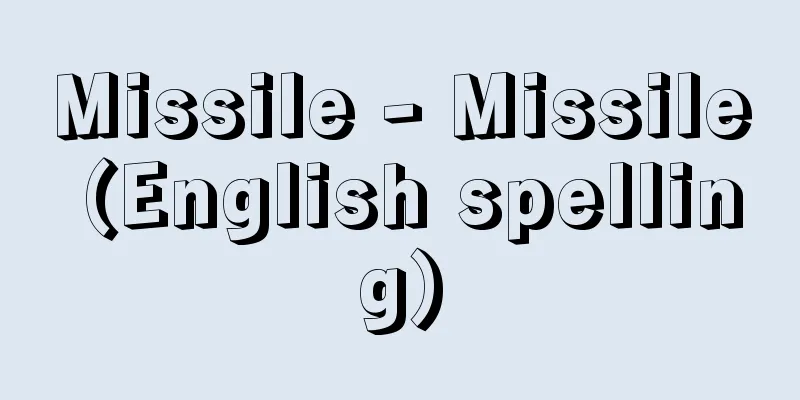Missile - Missile (English spelling)

|
Originally it meant a projectile, but in recent years it has come to mean a weapon that flies at high speed with an automatic propulsion system such as a rocket or jet engine. Missiles currently in use use a system that guides them to the target while correcting their course during flight, and are sometimes called guided missiles (GM). In some countries, they are not called missiles, but rather rockets, rocket weapons, or guided weapons. [Hattori Manabu] History of developmentThe first recorded rocket-powered weapon is said to be the flying spear used by the Jin army in a war against the Tatars in China in 1232. It was a weapon that had gunpowder loaded onto the tip of a spear, and emitted flames with a roaring sound to intimidate the enemy. In the 15th century, a weapon called the flying spear was used during the Ming dynasty, which used the recoil of the gunpowder gas to launch the spear far away, and it seems more accurate to consider this to be the first military use of rockets as a form of propulsion. In Europe, rocket weapons were developed by the British sergeant Congreve (1804), and since the Royal Navy used them to attack the French fleet at the port of Boulogne in 1806, they have been used in wars all over Europe, including India. In the 1840s, the British sergeant Hale developed the Hale rocket, an improvement on the Congreve rocket. The United States used a large number of Hale rockets in the Mexican War and the American Civil War. It is said that French rockets proved effective in attacking the Sevastopol fortress in the Crimean War. However, as rifles and cannons developed, this type of weapon, which had poor accuracy, disappeared. After Germany lost the First World War, the Treaty of Versailles prohibited the development and ownership of medium-caliber or larger artillery. In late 1929, the German Army began developing large rocket weapons. At the rocket development center established in Peenemünde, von Braun worked under Dornberger to develop a liquid-fueled rocket. The A4 rocket, which was test-fired in October 1942, was the first to fly at supersonic speeds for 320 kilometers. This rocket used alcohol as fuel and liquid oxygen as an oxidizer. The V2 weapon (weight 12.5 tons, range 350 kilometers) with a 750-kilogram explosive warhead was launched toward London on September 8, 1944, and since then, about 2,700 of these have been launched toward Britain and the Netherlands. Of these, 517 are believed to have fallen on London. The German Air Force also developed the Fi103 unmanned aircraft equipped with a pulse jet engine towards the end of World War II. Hitler attached 900 kilograms of explosives to this and named it the V1 weapon (weight 2.2 tons, range 280 km). It began attacking London from June 1944 onwards, ahead of the V2, and more than 10,000 were fired. However, while the V2 was supersonic (Mach 2.5), the V1's speed was comparable to that of fighter planes of the time, and many were shot down along the way. Furthermore, Germany developed wire-guided rocket-propelled air-to-air missiles, such as the X4, and radio-guided surface-to-air missiles, such as the R1, R3, and Hs117, during World War II, some of which were used on the Western Front, but they were not ready in time for actual combat. The Hs293 radio-guided gliding bomb dropped from aircraft was used in combat from August 1943, but this was essentially an air-to-ship or air-to-surface missile. Meanwhile, bazooka-type anti-tank rockets had been used in large numbers by various countries since around 1942. Also, from around 1941, the Soviet Union used multiple rocket launchers, named Katyushas, on the battlefield. After the end of World War II, the Peenemunde Test Site where the V2 was developed came under the occupation of the Soviet Army, and von Braun and other engineers who completed the V2 went to the United States. The United States and the Soviet Union focused on the competition to develop large rockets, which led to the development of various missile weapon systems today. The V1 became the origin of the unmanned aircraft-type missiles developed in the United States after the war, such as the Matador and Snark, which further developed into the modern cruise missile, and the V2 developed into today's long-range ballistic missile. Today, missiles have become important in the weapons system because, first, with the development of nuclear weapons, they have come to be used as a means of transporting nuclear warheads, and second, with the development of guidance technology, they have come to be used in actual combat as precision-guided tactical weapons. [Hattori Manabu] Propulsion and Guidance SystemsMissile propulsion methods can be broadly divided into rockets and jet engines. In the case of rockets, the internal fuel and oxidizer are burned, and the reaction force of the combustion gas jet propels the missile. Ballistic missiles use this method. Many early missiles used liquid fuel, but solid fuel, which is easier to handle, has gradually come to be used. In the case of jet propulsion, thrust is obtained by burning fuel while drawing in air, so the missile flies within the atmosphere and is slower than ballistic missiles which fly outside the atmosphere. Cruise missiles use this method. There are various types, such as turbofan jets, ramjets, and pulse jets (which are rarely used). There are various methods of technology to guide missiles to their target. Homing (automatic tracking) is when the missile itself detects the target and corrects its course to reach the target. There are passive homing methods, which capture and track the target's emitted radio waves, heat, light, sound, etc., active homing methods, which use radio waves or laser beams emitted from the missile itself and use the reflected waves from the target to track it, semi-active homing methods that use reflected waves of radio waves or laser beams emitted from the missile's launch aircraft, and optical homing methods that identify and track the target's shape using television or other means. A command guidance method is a method in which the launch aircraft issues a command to correct the course of a launched missile by radio, wire, radio waves, laser beams, television, etc. Program guidance is a method in which the course to the target is set before the missile is launched, and deviations from the set value are measured during flight and corrected accordingly; this method is used for long-range ballistic missiles. There are inertial guidance using gyros and accelerometers, celestial guidance that confirms the missile's position by observing celestial bodies and artificial satellites, and geodetic guidance that measures land topography, magnetic fields, gravity, etc. Further development of guidance methods progressed, and in the 1990s the GPS (Global Positioning System) system was adopted, which greatly improved the accuracy of hits using information from artificial satellites. Its effectiveness was particularly demonstrated during the Gulf War. [Hattori Manabu] Nuclear missilesMissiles have come to play an important role as a means of delivering nuclear warheads. Missiles equipped with nuclear warheads are called nuclear missiles. Nuclear missiles are often classified as strategic or tactical depending on their use. This classification is mainly based on the missile's range. However, since weapons in between strategic and tactical nuclear weapons have come to be called theater nuclear weapons, the distinction between these has become ambiguous. Generally, strategic nuclear weapons are weapons that have a range of 6,400 kilometers or more and can launch nuclear attacks on targets. Intercontinental Ballistic Missiles (ICBMs) and Submarine Launched Ballistic Missiles (SLBMs) fall into this category. Air Launched Cruise Missiles (ALCMs) carried by long-range bombers also fall into the category of strategic nuclear weapons. ICBMs, SLBMs, and long-range bombers are sometimes called the triad of strategic nuclear forces. The number of nuclear weapon delivery vehicles was the subject of the First Strategic Arms Limitation Negotiations and the Second Strategic Arms Limitation Treaty (SALT) between the United States and the Soviet Union. Missiles with a shorter range than strategic missiles were previously considered intermediate-range ballistic missiles (IRBMs) with a range of 2,400 to 6,400 km, medium-range ballistic missiles (MRBMs) with a range of 800 to 2,400 km, and tactical nuclear weapons. However, the INF Treaty of December 1987 defined intermediate-range missiles as those with a range of 1,000 to 5,500 km, and short-range missiles as those with a range of 500 to 1,000 km. This includes cruise missiles. [Hattori Manabu] The US-Soviet strategic missile raceIn March 1954, the United States detonated a working hydrogen bomb at Bikini Atoll, and the Soviet Union also detonated a full-scale hydrogen bomb in November 1955. Development of long-range strategic missiles capable of carrying such nuclear warheads began, and in May 1957, the United States successfully launched its first IRBM, the Jupiter. In August, the Soviet Union made its first successful flight of an ICBM, and in December, the United States successfully launched its first ICBM, the Atlas. Using these powerful rockets, the Soviet Union successfully launched its first artificial satellite, Sputnik 1, in October 1957, and the United States successfully launched Explorer 1 in January 1958. In the early 1960s, both the United States and the Soviet Union began deploying ICBMs. Following the Atlas, the United States developed the Titan, Minuteman, and Peacekeeper (MX missiles). The Soviet Union successively commissioned ICBMs, including the SS-6, SS-7, SS-8, SS-9, SS-11, SS-13, SS-17, SS-18, SS-19, SS-24, and SS-25. Meanwhile, plans to equip submarines with missiles also began toward the end of World War II. In September 1954, the United States completed its first nuclear submarine, the Nautilus. By combining nuclear missiles with nuclear submarines, which have long diving times and cruising distances, nuclear submarines as hidden, mobile missile bases began to play an important role in nuclear strategy. Regulus missiles equipped with nuclear warheads were first installed on five conventional submarines, but one of them, the Halibut, was converted into a nuclear submarine midway through the project, and was soon replaced by the SLBM Polaris missile, which was developed. In July 1960, the nuclear submarine George Washington succeeded in launching a Polaris missile from underwater for the first time, and began to deploy them. Meanwhile, the Soviet Union also succeeded in launching an SLBM underwater in July 1962, and began to deploy SLBMs such as the SSN4 around 1964. As for SLBMs, the United States developed missiles such as Polaris, Poseidon, and Trident, and currently deploys the Trident II (D-5) missile. The former Soviet Union developed the SS-N-5, SS-N-6, SS-N-7, SS-N-8, SS-N-17, SS-N-18, SS-N-20, and SS-N-23. Currently, other than the United States and Russia, the only country that possesses ICBMs is China, while the other three countries possess SLBMs are the United Kingdom, France, and China. [Hattori Manabu] Accuracy and MIRVingWhen using strategic missiles to attack and destroy specific, solid targets, such as enemy missile launch sites, rather than broad targets such as cities and industrial facilities, it is much more effective to improve the accuracy of the hit than to increase the power of the warhead. The ability to destroy a specific target is proportional to the two-thirds power of the warhead and inversely proportional to the square of the error probability radius (the radius of the circle centered on the target point on which half of the launched warheads will fall). In other words, if the error probability radius can be reduced by half, the destructive effect can be achieved in the same way as if the warhead was eight times more powerful. In the late 1960s, the United States began developing MIRV (Multiple Independently targetable Re-entry Vehicle) strategic ballistic missiles. MIRVing is a method of attaching multiple nuclear warheads to a single missile, launching it, and then guiding each warhead to a different target after the rocket is detached and the missile begins ballistic flight, with the aim of achieving extremely high accuracy. The deployment of MIRVed missiles began with the Minuteman III ICBM in 1970. The error probability radius of the first American ICBM, the Atlas, deployed in 1959, was about 3,700 meters, and that of the Titan II, deployed in 1963, was 900 meters, but the error probability radius of the MIRVed Minuteman III was 120 meters. SLBMs have also been MIRVed. The Soviet Union was a little later, beginning the widespread development of MIRVed missiles around 1973, but their accuracy was still significantly inferior to that of the United States. The MIRVing of strategic missiles has not only significantly increased nuclear power, but also had a major impact on nuclear strategy. MIRVed missiles, which have a large number of warheads and good accuracy, can destroy the enemy's many missile launch silos by launching only a few of them. In other words, it has become technically possible to launch a preemptive nuclear attack without worrying about retaliatory attacks. This has undermined the so-called nuclear deterrence theory, and increased the risk of nuclear war. MIRVed missiles improve their accuracy by making fine corrections to their trajectory during ballistic flight outside the atmosphere, but it is inevitable that the warhead will deflect due to the atmosphere after re-entering the atmosphere. To correct this, the ability to control the re-entered warhead itself is required. This is the technology known as the MaRV (Maneuvering Re-entry Vehicle) system. [Hattori Manabu] ABM and SDIAt the end of the 1960s, the development of ABMs (Anti-Ballistic Missiles) began, which are missiles designed to intercept strategic missiles launched by other countries before they reach the country and destroy them with a nuclear explosion. However, in the First Strategic Arms Limitation Talks (SALT-I) in May 1972, the United States and the Soviet Union concluded the ABM Limitation Treaty, which limited the deployment of ABM systems in both countries to two regions (capitals and ICBM launch bases). The ABM Protocol of July 1974 reduced deployment to one region and set a maximum of 100 missiles. However, the effectiveness of ABMs decreased with the introduction of MIRVs in offensive missiles, so the United States abolished the deployment of ABMs in 1975. The Soviet Union deployed an ABM network of missiles called GALOSH around Moscow. In March 1983, President Reagan of the United States ordered the development of a new weapon system that would destroy strategic missiles launched by enemy countries from outer space using powerful laser beams and high-energy particle beams. This came to be called SDI (Strategic Defense Initiative). However, it was said that it would be technically impossible to complete an SDI system that could destroy multiple strategic missiles launched simultaneously with 100% certainty within a few minutes. Also, if multiple decoy missiles were launched, it would be difficult to distinguish them. Furthermore, this technology would be useless against cruise missiles that fly at very low altitudes. In international politics, there were issues such as whether the deployment of SDI weapons would violate the ABM Treaty, which complicated nuclear disarmament negotiations. However, in 1993, when the Clinton administration took over, SDI was replaced by TMD (Theater Missile Defense), which combined a system that intercepts missiles at high altitudes, including outside the atmosphere, with a system that intercepts them at low altitudes within the atmosphere. Furthermore, in 2001, the George W. Bush administration came up with a new ballistic missile defense (BMD, also simply called MD) concept that combined TMD and NMD (national missile defense). In order to promote this missile defense, the United States notified Russia in December 2001 that it would withdraw from the ABM Treaty, and officially withdrew the following June. [Hattori Manabu] Cruise missilesA cruise missile is a winged missile equipped with a jet engine, and is defined in the Strategic Arms Limitation Treaty II (SALT-II) as "an unmanned, self-propelled, guided weapon delivery system which flies by aerodynamic lift for most of its flight path." The V1, used by the German army in World War II, is the original cruise missile, but after the war, the United States developed the Matador, Snark, Regulus, Mace A and B, and other missiles of this type. The former Soviet Union also developed the SS-N-2 and SS-N-3. Since then, ballistic missiles have developed significantly as long-range strategic missiles, so cruise missiles, which fly slowly in the atmosphere, have mainly been used as short-range tactical missiles. In the 1970s, the United States began developing a new generation of long-range cruise missiles. The Air Force adopted Boeing's AGM86B as an air-launched cruise missile (ALCM), and the Navy adopted McDonnell Douglas' Tomahawk as a sea-launched cruise missile (SLCM). There is also a ground-launched version of the Tomahawk (GLCM). These new cruise missiles come in two varieties: long-range (2,400 to 3,000 km) versions equipped with turbofan engines for nuclear warheads, and short-range versions equipped with turbojet engines for conventional warheads, but their external shapes are almost identical. Slow-speed cruise missiles are becoming important again because advances in propulsion and guidance technology have made it possible to fly at extremely low altitudes and achieve extremely high accuracy. They fly at extremely low altitudes - 30 meters over the sea, 50 meters over plains, and 100 meters over mountains - making them difficult to detect by radar. In addition to inertial guidance, they also use a Terrain Contour Matching system (TERCOM), which flies by matching the terrain read by radar with a map stored in a computer, resulting in extremely high accuracy. [Hattori Manabu] Tactical missilesCurrently, many countries around the world possess a wide variety of tactical missiles, and the Japanese Self-Defense Forces also deploy a variety of tactical missiles made in the United States and Japan. Most tactical missiles are equipped with conventional warheads and are used as tactical weapons in actual battlefields. However, some missiles can be used with both nuclear and conventional warheads. Tactical missiles can be classified as anti-surface, anti-ship, anti-submarine, anti-aircraft, anti-missile, anti-tank, and anti-radar, depending on the target they attack. In addition, they can be classified as surface-to-surface or ship-to-ship (SSM), surface-to-air or ship-to-air (SAM), air-to-surface or air-to-ship (ASM), ship-to-submarine (SUM), submarine-to-ship (USM), submarine-to-submarine (UUM), and air-to-air (AAM), depending on the combination of where they are equipped and where the target is located. Anti-tank missiles are sometimes called ATMs. The missiles used in the Vietnam War to target and attack enemy radar sources were called Anti-Radar Missiles (ARMs). Laser- or television-guided bombs were also called smart bombs. High-precision missiles that appeared after the 1970s are sometimes called Precision Guided Missiles (PGMs). Various missiles were used in the Vietnam War. In February 1965, the United States began bombing the North, but after July, US military aircraft were shot down one after another by SA-2 surface-to-air missiles provided by the Soviet Union. The US military tried to destroy the radars of the SA-2 positions with the air-to-surface anti-radar missile Shrike, but this was not very effective. The guided smart bombs that the US began using around the spring of 1972 were almost the same as missiles, and were highly accurate and effective. In the Third Arab-Israeli War in June 1967, the Israeli destroyer Eilat was sunk by three Soviet-made Styx ship-to-ship missiles fired from a missile boat of the Arab Union (now Egypt) Navy. This was the first time that a missile was used at sea to sink a ship. The Fourth Arab-Israeli War, which began in October 1973, was a war in which various surface-to-air missiles, air-to-air missiles, ship-to-ship missiles, and anti-tank missiles were used in earnest. The Soviet-made surface-to-air missile SA6 Gainful and the anti-tank missiles Snapper and Sagger equipped by the Arab side proved effective. Furthermore, in June 1981, an Israeli Air Force plane attacked the Osirak nuclear reactor under construction on the outskirts of Iraq's capital Baghdad with an air-to-surface missile, completely destroying it. In the Falklands War of 1982, an Argentine Air Force plane sank the British guided missile destroyer Sheffield with a single shot from a French-made Exocet AM39 anti-ship missile. Various missiles were also used in the Iran-Iraq War that began in 1981. In May 1987, an Exocet missile was mistakenly fired by the Iraqi military in the Persian Gulf, damaging the American frigate Stark. Many American-made Tomahawk cruise missiles (conventional warheads) were fired during the Gulf War. In August 1998, the US military fired 75 to 100 Tomahawks at Sudan and Afghanistan in retaliation for terrorist attacks. They were also used in large numbers in the attack on Iraq by US and British forces in December of the same year, and in the airstrikes on Yugoslavia by NATO forces from March 1999. [Hattori Manabu] "A History of the Development of World Weapons" by Akichi Riki (1976, Asahi Sonorama)" ▽ "Report of the United Nations Secretary-General: A Comprehensive Study of Nuclear Weapons" (1982, Rengo Publishing)" ▽ "The Cutting Edge of Weapons 7: Missiles and Nuclear Weapons" edited by The Yomiuri Shimbun (1986, The Yomiuri Shimbun)" ▽ "An Overview of the History of Weapons" by Saito Toshio (1987, Gakukensha)" ▽ "Missiles of the World" by Koto Gen (1997, Shinkigensha) " ▽ "Missile Encyclopedia: A Reference Guide to the World's Missiles" New Edition edited by Koto Gen, Digital Fact, Knowledge Project, and Shinkigensha Editorial Department (2000, Shinkigensha)" ▽ "Basic Knowledge of Missile Defense: Understanding the News: A Book to Correctly Understand the Threat of Missiles and the International Military Situation" by Koto Gen (2002, Shinkigensha)" ▽ "Missile Defense: A New Structure of International Security" by Morimoto Satoshi (2002, Japan Institute of International Affairs)" ▽ "World Missile Defense" by Yoshihiro Sakagami (2003, Ariadne Planning, Sanshusha Publishing) " "Introduction to Ballistic Missile Defense - New Nuclear Deterrence Strategy and Japan's BMD" by Hideaki Kaneda (2003, Kaya Shobo) "The Latest Missile Encyclopedia" by Gen Koto (2004, Shinkigensha) " TB Chran et al. Nuclear Weapons Databook Volume 1, US Nuclear Forces and Capabilities (1984, Ballinger Publishing Company)" [References] | | | | | | | | | |The Japan Ground Self-Defense Force's anti-ship and anti-tank missile and launcher. The missile is approximately 1.4m long and 14cm in diameter. Semi-active homing system. ©Shogakukan Medium-range multipurpose guided missile ©Shogakukan "> Main guidance methods for missiles A cruise missile launched from a missile carrier uses a radio altimeter and a barometric altimeter to read the terrain below, and compares this data with a pre-stored map of the target to correct its course. This is also called the terrain contour matching method. Terrain Elevation Comparator (TERCOM) In the case of an MX missile (four-stage rocket system), the guidance and control system (loaded onto the fourth-stage warhead-launching rocket) controls the rocket nozzle to control the flight direction and speed from the launch site (a) to the third-stage rocket separation point (b). After reaching the highest point (c), the MIRV warhead is launched toward each target, and the fourth-stage rocket motor is used to control this. The inertial guidance system used in many ICBMs can be seen in the figure on the left. A combination of three accelerometers measures the forward/backward, left/right, and up/down movement and speed, while a gyroscope measures data to keep the accelerometers stable so that they maintain their initial direction. ©Shogakukan "> Inertial Guidance Method ©Toshihisa Watanabe "> Structure of the Tomahawk cruise missile Source: Shogakukan Encyclopedia Nipponica About Encyclopedia Nipponica Information | Legend |
|
もともとは飛び道具といった意味であったが、近年はロケットあるいはジェットエンジンのような自動推進装置を備えて高速で飛行する兵器をさすことが多くなった。現在使われているミサイルは、飛行中に進路を修正しながら目標に誘導する装置を利用しており、誘導ミサイルGuided Missile(GM)とよばれることもある。また国によってはミサイルとよばず、ロケット、ロケット兵器、あるいは誘導兵器とよぶこともある。 [服部 学] 発達の歴史1232年に中国で、金(きん)の軍がタタール軍との戦争で使った飛火槍(ひかそう)という兵器が、記録に残っている最初のロケット式兵器であるとされている。これは、槍(やり)の先に火薬をつめ、轟音(ごうおん)とともに火焔(かえん)を噴き出して相手を威嚇する兵器であったらしい。15世紀になって明(みん)代に使われた飛槍(ひそう)とよばれる兵器が、火薬の噴射ガスの反動で槍を遠くに飛ばすもので、これが推進力としてのロケットの軍事利用の最初であるとみなすほうが正しいようである。 ヨーロッパでは、イギリスのコングリーブがロケット兵器を開発(1804)し、1806年にイギリス海軍がブローニュ港のフランス艦隊を攻撃するのに用いて以来、ヨーロッパの各地の戦争で使われ、インドでも使われている。1840年代にイギリスのヘールが、コングリーブ・ロケットを改良したヘール・ロケットを開発した。アメリカは、メキシコ戦争や南北戦争で多数のヘール・ロケットを使用した。またクリミア戦争では、フランスのロケットがセバストポリ要塞(ようさい)の攻撃に威力を発揮したといわれる。しかし小銃や大砲が発達してくるにつれて、命中精度のよくないこの種の兵器は姿を消していった。 第一次世界大戦に敗れて、ベルサイユ条約で中口径以上の大砲の開発・所有を禁止されたドイツでは、1929年末から陸軍が大型ロケット兵器の開発を始めた。ペーネミュンデにつくられたロケット開発センターでは、ドルンベルガーの下でフォン・ブラウンが、液体燃料を使ったロケットの開発にあたった。1942年10月に発射実験を行ったA4ロケットは、初めて超音速で320キロメートルを飛行した。このロケットはアルコールを燃料とし、液体酸素を酸化剤として使っていた。これに750キログラムの火薬弾頭をつけたV2号兵器(重量12.5トン、射程350キロメートル)は、1944年9月8日ロンドンに向けて発射されて以来、約2700発がイギリスとオランダに向けて発射された。このうちロンドンに落下したのは517発であったとされている。 またドイツ空軍は、やはり第二次世界大戦末期に、パルスジェットエンジンをつけた無人飛行機Fi103を開発した。これに900キログラムの爆薬をつけたものを、ヒトラーがV1号兵器と命名した(重量2.2トン、射程280キロメートル)。V2号より先に、1944年6月以降ロンドン攻撃を開始し、1万発以上が発射された。しかしV2号が超音速(マッハ2.5)であったのに比べ、V1号の速度は当時の戦闘機なみであり、途中で撃墜されるものが多かった。 さらにドイツは第二次世界大戦中に、有線誘導のロケット推進空対空ミサイル、X4や、無線誘導の地対空ミサイル、R1、R3、Hs117などを開発し、一部は西部戦線で使われたが、実戦にはほとんどまにあわなかった。航空機から投下する無線誘導の滑空爆弾Hs293は、1943年8月から実戦に使われたが、これも実質的には空対艦あるいは空対地ミサイルであった。一方、対戦車ロケットは、1942年ごろからバズーカ型のものを各国が大量に使用している。また1941年ごろからソ連は、カチューシャと名づけた多連装ロケット弾を戦場で使用した。 第二次世界大戦終了後、V2号を開発したペーネミュンデ実験場はソ連軍の占領下に入り、またV2号を完成させたフォン・ブラウンその他の技術者はアメリカに渡った。米ソ両国は大型ロケット開発の競争に力を入れ、今日の各種のミサイル兵器体系が発達した。V1号は、戦後アメリカで開発された無人飛行機型ミサイルのマタドールやスナークなどの元祖となり、さらに近年の巡航ミサイルに発達し、V2号は今日の長距離弾道ミサイルに発達した。 今日、ミサイルが兵器体系のなかで大きな意味をもつようになったのは、一つは、核兵器の発達に伴い、核弾頭の運搬手段として使われるようになったことと、もう一つは、誘導技術の発達によって、戦術用の精密誘導兵器として実戦に用いられるようになったためである。 [服部 学] 推進方式と誘導方式ミサイルの推進方式には、大別してロケットとジェットエンジンがある。ロケットの場合は、内蔵する燃料と酸化剤とを燃焼させ、燃焼ガス噴射の反動で推進する。弾道ミサイルはこの方式である。初期のミサイルには液体燃料を使ったものが多かったが、しだいに取扱いの簡単な固体燃料が使われるようになってきている。ジェット推進の場合は、空気を吸入しながら燃料を燃焼させて推力を得るので、大気圏内を飛行することになり、大気圏外を飛ぶ弾道ミサイルと比べると速度が遅い。巡航ミサイルはこの方式である。ターボファンジェット、ラムジェット、パルスジェット(ほとんど用いられていない)などの方式がある。 ミサイルを攻撃目標に誘導する技術にもいろいろの方式がある。ミサイル自体が目標を探知し、進路を修正しながら目標に到達するのをホーミング(自動追尾)方式とよぶ。これにも、目標が出している電波、熱、光、音などをとらえて追跡するパッシブ・ホーミング方式、ミサイル自体から電波、レーザー光線などを発射し、それが目標から反射してくるのを使って追跡するアクティブ・ホーミング方式、ミサイルの発射母機などから発射する電波、レーザー光線などの反射波を利用するセミアクティブ・ホーミング方式、目標の形状をテレビなどで識別して追尾する光ホーミング方式などがある。 発射母機から、無線、有線、電波やレーザーのビーム、テレビなどで、発射したミサイルの進路の修正を指令して誘導する方式を指令誘導方式とよんでいる。またプログラム誘導方式というのは、ミサイルの発射前に目標までの進路を設定し、飛行中に設定値からのずれを測定して修正しながら飛行する方式で、長距離弾道ミサイルに用いられる。ジャイロと加速度計を用いる慣性誘導、天体や人工衛星を観測してミサイルの位置を確認する天測誘導、陸上の地形、磁場、重力などを測定する地測誘導などがある。さらに誘導方式の開発が進み、1990年代にはGPS(Global Positioning System=全地球測位システム)方式が採用され、人工衛星からの情報できわめて命中精度が高くなった。とくに湾岸戦争でその効果が示された。 [服部 学] 核ミサイルミサイルは核弾頭の運搬手段として重要な役割をもつようになってきた。核弾頭をつけたミサイルを核ミサイルとよんでいる。核ミサイルは、用途によって戦略用と戦術用に区分されることが多い。その区分は主としてミサイルの射程によるものである。しかし戦略核兵器と戦術核兵器の中間にあるものが戦域核兵器とよばれるようになってきたので、これらの区別はあいまいなものになってきている。 一般的には、6400キロメートル程度以上の射程をもち、目標に核攻撃を加えることのできる兵器を戦略核兵器とよんでいる。大陸間弾道ミサイルIntercontinental Ballistic Missile(ICBM)、潜水艦発射弾道ミサイルSubmarine Launched Ballistic Missile(SLBM)がこの部類に入る。また長距離爆撃機で運ばれる空中発射巡航ミサイルAir Launched Cruise Missile(ALCM)も戦略核兵器の部類に入る。ICBM、SLBM、長距離爆撃機の三者を戦略核戦力の三本柱とよぶことがある。米ソ間の第一次戦略兵器制限交渉および第二次戦略兵器制限条約(SALT(ソルト))の対象となったのは、これらの核兵器運搬手段の数であった。 戦略ミサイルよりも射程の短いものは、射程2400ないし6400キロメートル程度のものが中距離弾道ミサイルIntermediate Range Ballistic Missile(IRBM)、射程800ないし2400キロメートル程度のものが準中距離弾道ミサイルMedium Range Ballistic Missile(MRBM)、それ以下は戦術核兵器とされていた。しかし1987年12月のINF(中距離核戦力)全廃条約では、射程1000ないし5500キロメートルのものを中距離ミサイル、500ないし1000キロメートルのものを短距離ミサイルと定義した。これには巡航ミサイルも含まれている。 [服部 学] 米ソの戦略ミサイル開発競争1954年3月、アメリカはビキニ環礁で実用水素爆弾の爆発実験を行い、旧ソ連も1955年11月に本格的な水素爆弾を爆発させた。こうした核弾頭を運ぶ長距離戦略ミサイルの開発が始まり、1957年5月、アメリカは最初のIRBMジュピターの発射に成功した。8月にはソ連がICBMの最初の飛行に成功し、12月にアメリカは最初のICBMアトラスの打上げに成功した。これらの強力なロケットを使って、ソ連は1957年10月に最初の人工衛星スプートニク1号を、アメリカは1958年1月にエクスプローラ1号の打上げに成功した。 1960年代の初めに、米ソ両国はICBMの配備を始めた。アメリカではアトラスに次いでタイタン、ミニットマン、ピースキーパー(MXミサイル)などが開発された。ソ連ではSS‐6、SS‐7、SS‐8、SS‐9、SS‐11、SS‐13、SS‐17、SS‐18、SS‐19、SS‐24、SS‐25などのICBMが次々と就役した。 一方、潜水艦にミサイルを搭載する計画も、第二次世界大戦の末期から始められていた。1954年9月に、アメリカは最初の原子力潜水艦ノーチラス号を完成した。潜水時間と航続距離の長い原子力潜水艦と核ミサイルを結び付けることによって、隠れて移動できるミサイル基地としての原子力潜水艦が、核戦略のなかで重要な役割を占めるようになってきた。核弾頭をつけたレギュラス・ミサイルは、最初に通常型潜水艦5隻に搭載されたが、そのうちのハリバット号は途中で原子力潜水艦に改造され、その後まもなくSLBMポラリス・ミサイルが開発されてこれにかわった。1960年7月、原子力潜水艦ジョージ・ワシントン号が初めて水中からポラリス・ミサイルの発射に成功し、配備を始めた。一方ソ連も、1962年7月にSLBMの水中発射に成功し、1964年ごろからSSN4などのSLBMの配備を始めた。 SLBMについては、アメリカではポラリスに次いでポセイドン、トライデントなどのミサイルが開発され、現在はトライデントⅡ(D‐5)ミサイルが配備されている。旧ソ連ではSS‐N‐5、SS‐N‐6、SS‐N‐7、SS‐N‐8、SS‐N‐17、SS‐N‐18、SS‐N‐20、SS‐N‐23などが開発された。 現在、米ロ以外でICBMを保有しているのは中国、SLBMを保有しているのはイギリス、フランス、中国である。 [服部 学] 命中精度とMIRV化戦略ミサイルを使用して、都市や産業施設のような広い目標ではなく、たとえば相手のミサイル発射基地のような特定の堅固な目標を攻撃して破壊するには、弾頭の威力を大きくするよりは、命中精度をよくするほうがずっと効果的である。特定の目標を破壊する能力は、弾頭の威力の3分の2乗に比例し、誤差確率半径(目標点を中心として、発射した弾頭の半数が落下する円の半径)の2乗に反比例する。つまり誤差確率半径を半分に縮められれば、弾頭の威力を8倍強力にするのと同じ破壊効果が得られることになる。 1960年代の後半に、アメリカは戦略弾道ミサイルのMIRV(マーブ)(Multiple Independently targetable Re-entry Vehicle=複数独立目標弾頭、多弾頭誘導弾とも)化の開発を始めた。MIRV化というのは、1基のミサイルに複数の核弾頭を取り付けて発射し、ロケットを切り離して弾道飛行に移ったのち、弾頭を1発ずつ別々の目標に誘導し、しかもその命中精度を非常によくしようとする方式である。MIRV化ミサイルの配備は、1970年のミニットマンⅢ型ICBMから始まった。1959年に配備されたアメリカ最初のICBMアトラスの誤差確率半径は約3700メートル、1963年に配備されたタイタンⅡ型では900メートルであったが、MIRV化されたミニットマンⅢ型の誤差確率半径は120メートルとなった。SLBMもMIRV化された。 旧ソ連はすこし遅れて1973年ごろから広範にMIRV化ミサイルの開発を始めた。しかし命中精度はアメリカと比べてかなり劣っていた。 戦略ミサイルのMIRV化は、核戦力を著しく増強したばかりでなく、核戦略にも大きな影響を及ぼした。弾頭数が多く命中精度のよいMIRV化ミサイルならば、少数を発射しただけで相手の多数のミサイル発射サイロを先に破壊してしまうことができる。つまり報復攻撃の心配をせずに先制核攻撃を加えることが技術的に可能となってきた。これは、いわゆる核抑止力論を破綻(はたん)させることになり、核戦争の起こる危険性を大きくしている。MIRV化ミサイルは、大気圏外の弾道飛行中に細かい軌道修正を行うことで命中精度を高めているが、弾頭が大気圏内に再突入してからの大気による航路の偏向は避けられない。これを補正するには、再突入した弾頭自体を操縦する能力が必要になる。これがMaRV(マーブ)(Maneuvering Re-entry Vehicle=進路修正弾頭)方式とよばれる技術である。 [服部 学] ABMとSDI1960年代の終わりごろから、発射された相手国の戦略ミサイルを、自国に到達する前に迎撃して核爆発によってこれを破壊しようとするミサイル、ABM(Anti-Ballistic Missile=弾道弾迎撃ミサイル)の開発が始まった。しかし米ソ両国は、1972年5月の第一次戦略兵器制限交渉(SALT‐Ⅰ)のなかで、両国のABM体系の配備を2地域(首都とICBM発射基地)に制限するABM制限条約を結んだ。そして1974年7月のABM議定書では、配備を1地域に減らし、最高100基までとした。しかし攻撃ミサイルのMIRV化によってABMの有効性が低下してきたので、アメリカは1975年にABMの配備を廃止した。ソ連はモスクワ周辺にガロッシュとよばれるミサイルによるABM網を配備した。 1983年3月、アメリカの大統領レーガンは、発射された相手国の戦略ミサイルを、宇宙空間から強力なレーザー光線や高エネルギー粒子線などを使って破壊しようとする新しい兵器体系の開発を命令した。これがSDI(Strategic Defense Initiative=戦略防衛構想)とよばれるようになった。しかし同時に発射された多数の戦略ミサイルを数分のうちに100%確実に破壊できるようなSDI体系を完成させることは、技術的にも不可能であろうといわれていた。また、おとりのミサイルが多数発射されれば、これを見分けることも困難であろう。さらに、超低空を飛行する巡航ミサイルに対しては、この技術は役にたたない。国際政治の面では、SDI兵器の配備はABM制限条約に反するのではないかという点なども問題となっており、核軍縮交渉を複雑なものにした。しかし、1993年クリントン政権になると、SDIは、大気圏外を含む高層でミサイルを迎撃するシステムと大気圏内の低層で迎撃するシステムを組み合わせたTMD(Theater Missile Defense=戦域ミサイル防衛)にとってかわられた。さらに、2001年G・W・ブッシュ政権になると、TMDとNMD(国家ミサイル防衛)を包括した新たな弾道ミサイル防衛(BMD。単にMDともいう)構想が打ち出された。なお、アメリカはこのミサイル防衛を推進するため、2001年12月ABM制限条約から脱退することをロシアに通告、翌年6月正式に脱退した。 [服部 学] 巡航ミサイル巡航ミサイルCruise Missileとは、ジェットエンジンをつけた有翼ミサイルのことで、第二次戦略兵器制限条約(SALT‐Ⅱ)では、「飛行経路の大部分を空気力学的な揚力で飛行する無人自己推進誘導兵器運搬装置」と定義されている。 第二次世界大戦でドイツ軍が使ったV1号が巡航ミサイルの元祖にあたるが、戦後アメリカは、この型のミサイルとしてマタドール、スナーク、レギュラス、メースAおよびBなどを開発した。旧ソ連もSS‐N‐2、SS‐N‐3などを開発した。その後、長距離戦略ミサイルとしては弾道ミサイルが著しく発達したので、大気圏内を飛び速度の遅い巡航ミサイルは主として短距離戦術ミサイルとして使われてきた。1970年代に入って、アメリカは新しい世代の長距離巡航ミサイルの開発を始めた。空軍は空中発射巡航ミサイルAir Launched Cruise Missile(ALCM)としてボーイング社のAGM86Bを採用し、海軍は水上および水中発射巡航ミサイルSea Launched Cruise Missile(SLCM)としてマクダネル・ダグラス社のトマホークを採用した。トマホークには陸上発射型のGLCM(Ground Launched Cruise Missile)もある。これらの新型巡航ミサイルには、核弾頭用にターボファンエンジンをつけた長射程(2400ないし3000キロメートル)のものと、通常弾頭用にターボジェットエンジンをつけた短射程のものがあるが、外形はほとんど変わらない。 速度の遅い巡航ミサイルがふたたび重視されるようになってきたのは、推進技術および誘導技術の進歩により、超低空を飛んで命中精度を非常によくすることができるようになったからである。海上では30メートル、陸地では平野部で50メートル、山地でも100メートルという超低空を飛ぶので、レーダーに発見されにくい。また慣性誘導のほかに、地形標高照合方式Terrain Contour Matching system(TERCOM(ターカム))を用い、レーダーで読んだ地形をコンピュータに記憶させた地図と照合しながら飛んでいくので、きわめて命中精度が高くなる。 [服部 学] 戦術ミサイル現在世界の各国は多種多様な戦術ミサイルを保有しているが、日本の自衛隊もアメリカ製および日本製の各種の戦術ミサイルを配備している。戦術ミサイルの多くは通常弾頭をつけたもので、実際の戦場で戦術兵器として用いられている。しかし核弾頭と通常弾頭の両用のものもある。戦術ミサイルは、攻撃する目標によって、対地用、対艦艇用、対潜水艦用、対航空機用、対ミサイル用、対戦車用、対レーダー用などと分類されることがある。これとは別に、装備する場所と攻撃目標のある場所との組合せによって、地対地あるいは艦対艦(SSM)、地対空あるいは艦対空(SAM)、空対地あるいは空対艦(ASM)、艦対潜(SUM)、潜対艦(USM)、潜対潜(UUM)、空対空(AAM)などに区分されることもある。対戦車ミサイルはATMとよばれることがある。 ベトナム戦争で使われた相手のレーダー源を目標にして攻撃するミサイルはAnti-Radar Missile(ARM)とよばれた。またレーザーやテレビで誘導した爆弾はスマートSmart爆弾ともよばれた。1970年代以降に現れた高精度のミサイルを精密誘導ミサイルPrecision Guided Missile(PGM)とよぶことがある。 ベトナム戦争では各種のミサイルが実戦に使用された。1965年2月にアメリカは北爆を開始したが、7月以後、ソ連から供与された地対空ミサイルSA‐2で、アメリカ軍機が次々と撃墜されるようになった。アメリカ軍は空対地対レーダーミサイル、シュライクでSA‐2陣地のレーダーを破壊しようとしたが、これはあまり効果がなかった。アメリカが1972年春ごろから使用した誘導式のスマート爆弾は、ミサイルとほとんど同じようなもので、命中精度が高く効果をあげた。1967年6月の第三次中東戦争では、アラブ連合(現、エジプト)海軍のミサイル艇から発射されたソ連製艦対艦ミサイル、スティックス3発で、イスラエルの駆逐艦エイラート号が撃沈された。ミサイルが海上で使用され、艦艇を撃沈した最初の例であった。1973年10月に始まった第四次中東戦争は、各種の地対空ミサイル、空対空ミサイル、艦対艦ミサイル、対戦車ミサイルが本格的に使われた戦争であった。アラブ側が装備したソ連製地対空ミサイルのSA6ゲインフルや、対戦車ミサイルのスナッパーやサガーが威力を発揮した。さらに1981年6月には、イスラエル空軍機がイラクの首都バグダード郊外に建設中の原子炉オシラクを空対地ミサイルで攻撃し、これを完全に破壊するという事件も起こっている。1982年のフォークランド紛争では、アルゼンチン空軍機がフランス製対艦ミサイル、エグゾセAM39の1発でイギリスのミサイル駆逐艦シェフィールド号を撃沈した。1981年に始まったイラン・イラク戦争でも、各種のミサイルが使われている。1987年5月、ペルシア湾でイラク軍が誤って発射し、アメリカのフリゲート艦スターク号を大破させたのもエグゾセ・ミサイルであった。湾岸戦争では多数の巡航ミサイルであるアメリカ製のトマホーク(通常弾頭)が発射された。1998年8月、対テロ報復攻撃として、アメリカ軍は75~100発のトマホークをスーダンとアフガニスタンに発射した。さらに同年12月の米英軍によるイラク攻撃、1999年3月からのNATO(ナトー)(北大西洋条約機構)軍によるユーゴスラビア空爆にも多数使用された。 [服部 学] 『明地力著『世界兵器発達史』(1976・朝日ソノラマ)』▽『国連事務総長報告『核兵器の包括的研究』(1982・連合出版)』▽『読売新聞社編『兵器最先端7 ミサイルと核』(1986・読売新聞社)』▽『斎藤利生著『武器史概説』(1987・学献社)』▽『小都元著『世界のミサイル』(1997・新紀元社)』▽『小都元著、デジタルファクト・知識計画・新紀元社編集部編『ミサイル事典――世界のミサイル・リファレンス・ガイド』新版(2000・新紀元社)』▽『小都元著『ミサイル防衛の基礎知識――ニュースがわかる:ミサイルの脅威と国際軍事情勢について正しくわかる本』(2002・新紀元社)』▽『森本敏著『ミサイル防衛――新しい国際安全保障の構図』(2002・日本国際問題研究所)』▽『坂上芳洋著『世界のミサイル防衛』(2003・アリアドネ企画、三修社発売)』▽『金田秀昭著『弾道ミサイル防衛入門――新たな核抑止戦略とわが国のBMD』(2003・かや書房)』▽『小都元著『最新 ミサイル全書』(2004・新紀元社)』▽『T.B.Cochran et al.Nuclear Weapons Databook Volume 1, U.S. Nuclear Forces and Capabilities(1984, Ballinger Publishing Company)』 [参照項目] | | | | | | | | | |陸上自衛隊の対舟艇・対戦車ミサイルと発射装置。ミサイル全長約1.4m、ミサイル直径約14cm。セミアクティブ・ホーミング方式©Shogakukan"> 中距離多目的誘導弾 ©Shogakukan"> ミサイルのおもな誘導方式 ミサイル母機から発射された巡航ミサイルは、電波高度計と気圧高度計を使って下方の地形を読み取り、このデータをあらかじめ記憶させてある目標までの地図と照合して、コースを修正する。地形等高線照合方式ともいう©Shogakukan"> 地形標高照合方式(TERCOM) MXミサイル(4段ロケット方式)の場合、発射基地(a)から第3段ロケット切り離し点(b)までに、誘導制御システム(4段目の弾頭投射ロケットに積載)がロケットノズルをコントロールして、飛行方向・速度などを制御する。最高点(c)に達した後は、MIRV弾頭を各目標に向けて投射するが、その際の制御に4段目のロケットモーターが使われる。多くのICBMに使われる慣性誘導方式は、左図のように示すことができる。三つの加速度計を組み合わせ、前後、左右、上下の動きと速度を測定し、ジャイロスコープは加速度計が当初の方向を維持するように安定を保つためのデータを測定する©Shogakukan"> 慣性誘導方式 ©渡部利久"> 巡航ミサイル「トマホーク」の構造 出典 小学館 日本大百科全書(ニッポニカ)日本大百科全書(ニッポニカ)について 情報 | 凡例 |
Recommend
soldier beetle
…There are about 1,500 species of Canthariidae in...
orchestra
… [Tetsuo Kishi] [Western theater architecture] T...
Ganga [river] - Ganga
Also known as the Ganges. A large river in India. ...
Morrison Incident
In the late Edo period, an American ship that had...
Unio mystica (English spelling)
...Although this already suggests an experience t...
Shangri-La - Togenkyo
A Chinese fairyland, one of the otherworldly realm...
administrative officer
It was one of the "Seven Offices" establ...
Hironao Ouchi - Hironao Ouchi
… Hirako Shigetsugu and others were deprived of t...
Anatidae
…A general term for birds belonging to the Anatid...
Atlas (Saturn)
…However, Voyager discovered or confirmed many mo...
Cibber, Colley
Born: November 6, 1671, London [died] December 11,...
Evaporation - johatsu (English spelling) vaporization
Evaporation occurs when vaporization occurs from ...
Ai (indigo) - Ai (English spelling) Chinese indigo
An annual plant of the Polygonaceae family (APG c...
Toad Drawstring Bag - Gamakinchaku
…In the past, people used pouches to hold coins, ...
Alleanza del Lavoro
...The People's Sturmabteilung was an autonom...









